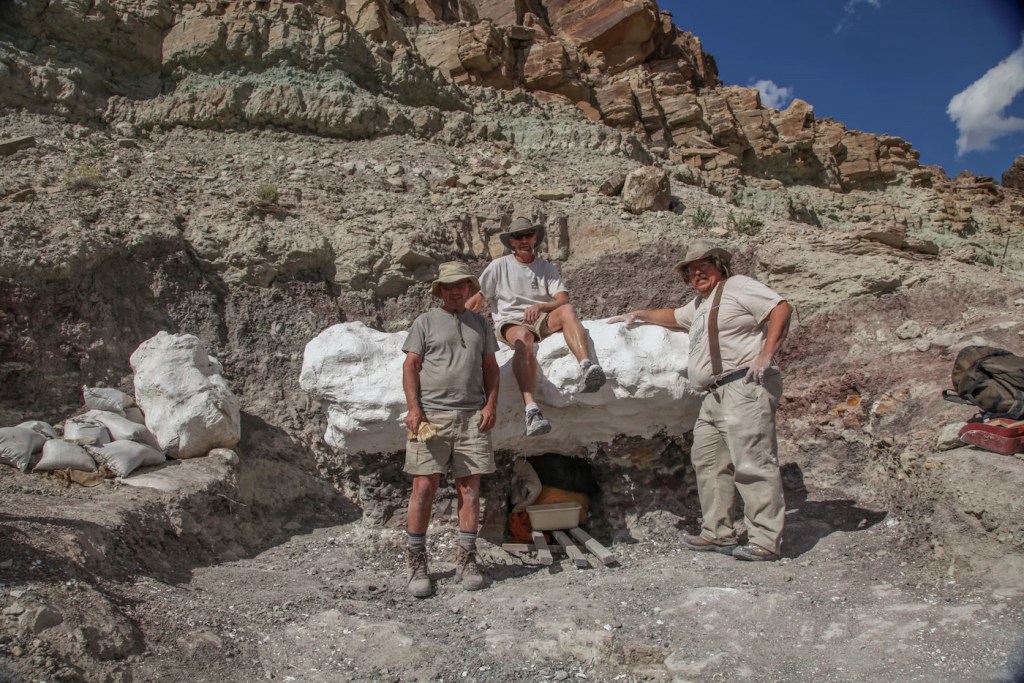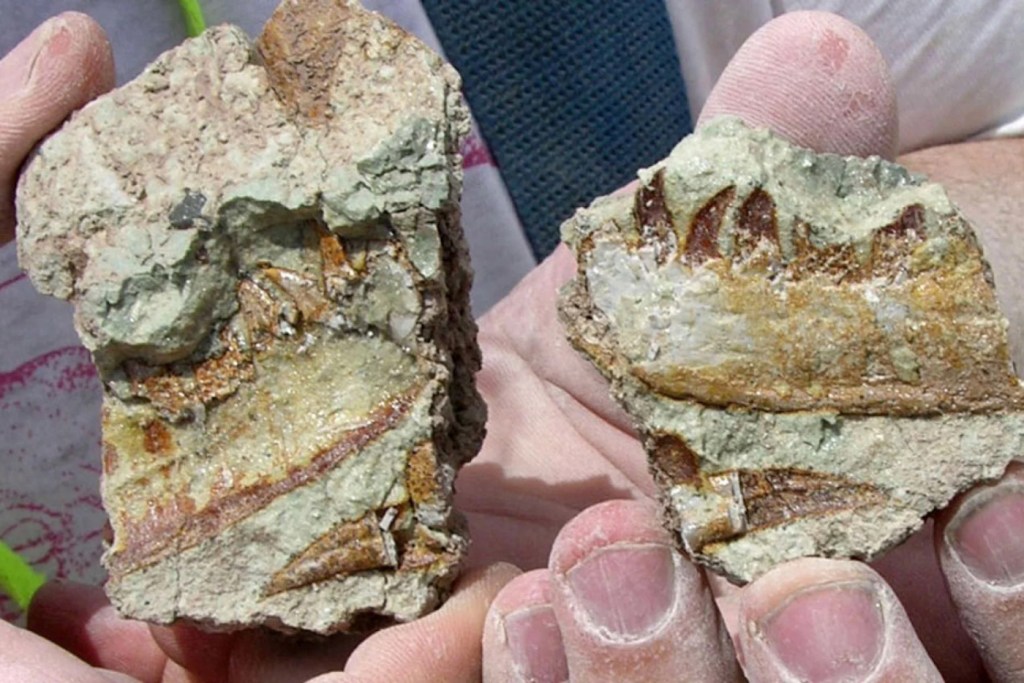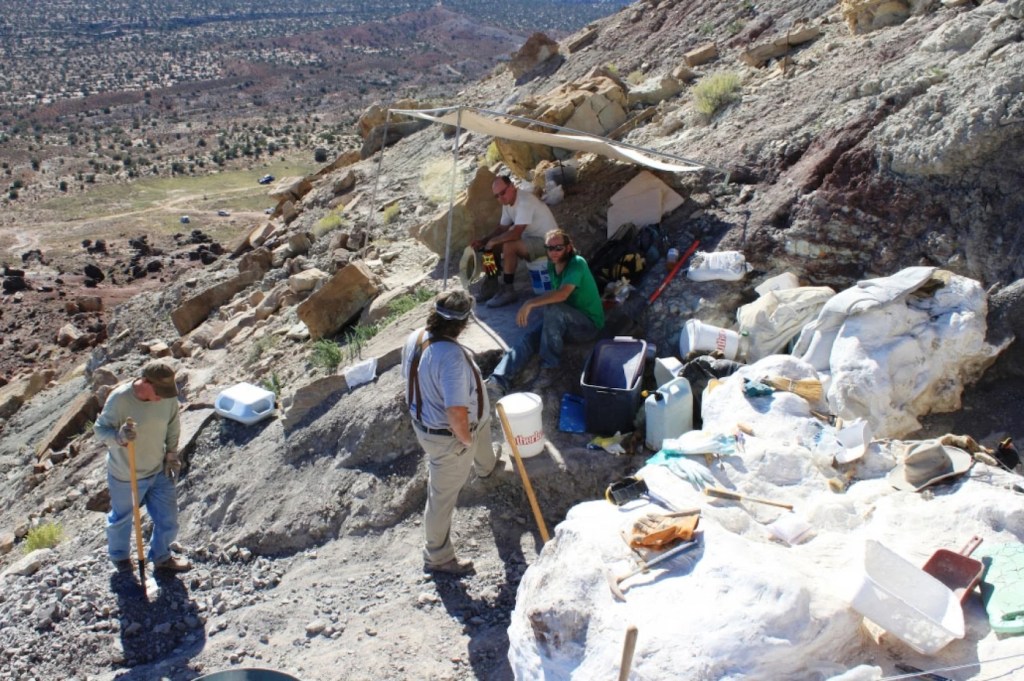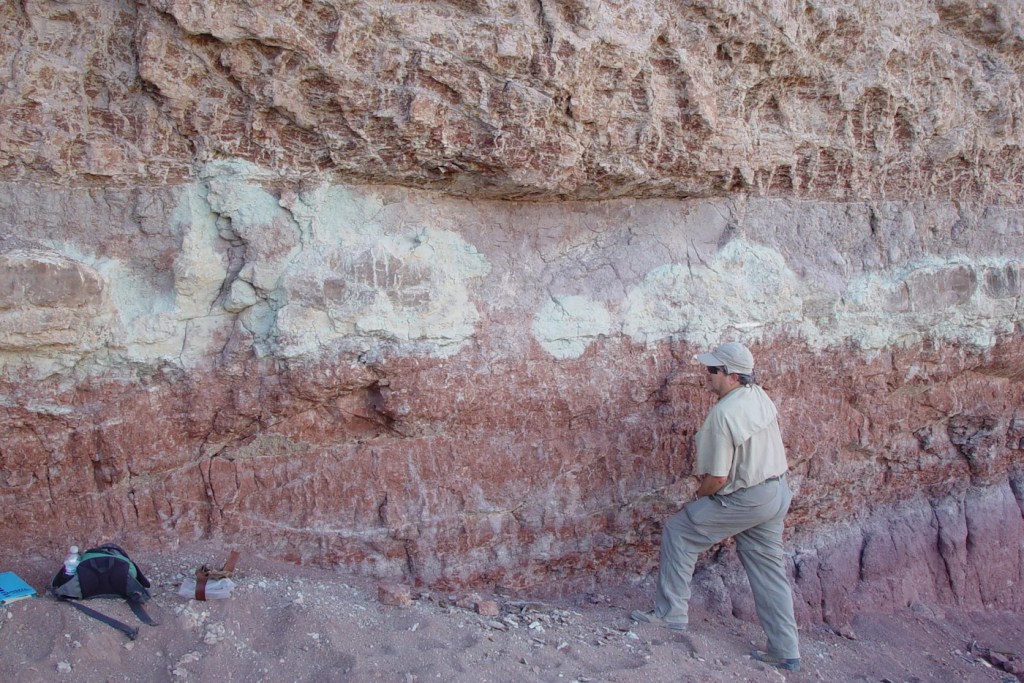Thanks To A Mesozoic Hot Spot, We Finally Know How Old The Utahraptor Is
6:41 minutes

This article is part of The State of Science, a series featuring science stories from public radio stations across the United States. This story, by David Condos, was originally published by KUER.
Sometimes Jim Kirkland wishes he had been alive 150 years ago.
That’s when the golden age of North American dinosaur discovery began, and early titans of paleontology crisscrossed the Rocky Mountains unearthing dozens of new species that became household names, from the Stegosaurus to the Brontosaurus to the Triceratops.
But a close second to that era is what Kirkland gets to see these days in Utah.
“I am doing that kind of discovery right now,” Kirkland said. “I’m just lucky to be alive.”
Kirkland, Utah’s state paleontologist, uncovered and named the Utahraptor in 1993. The deadly predator became the official state dinosaur in 2018.
Weighing more than 600 pounds, the Utahraptor used its nearly 10-inch claws to tear prey apart. These raptors were roughly the size of the clever villains depicted in the Jurassic Park movies — Velociraptors were actually closer to the size of a chicken.

His latest discovery is part of a groundbreaking new study that establishes the Utahraptor’s absolute age for the first time. Thanks to samples from the Stikes Quarry site near Moab, scientists now believe the dinosaur is 135 million years old — 10 million years older than previously thought.
This research has implications beyond merely expanding our knowledge of Utah’s state dinosaur, he said. It changes the way scientists understand the grand chain of evolutionary history by closing a big gap in the fossil record.
“We’ve got a whole story here that didn’t exist a few years ago,” Kirkland said. “Thirty-five million years of the history of Utah is just being unveiled in front of our eyes.”
Around the time the Jurassic period transitioned to the Cretaceous, there are roughly 25 million years missing in the fossil record. Nearly everywhere else on Earth — except this remote section of Utah — the rocks from that era simply washed away before compacting into sediments.
That left paleontologists guessing what happened during that time. Did animals slowly evolve into new species? Or did a mass extinction hit the reset button?
“No one would have the guts to say that because it was such a big gap. … But now we know this is total turnover,” Kirkland said. “For the first time, Grand County is going to be ground zero for looking at the extinction at the end of the Jurassic.”
This initial discovery, he said, might also eventually lead to some other answers, such as revealing new links in the family tree that connects dinosaurs to modern birds. And this pocket of southern Utah is the only place to find rocks from that time.
That’s thanks to the slow-moving salt deposits underneath the rock layers, which shaped the Earth’s crust in such a way that it kept the sediments from eroding away completely. It’s the same geological dynamic, he said, that gives the Moab area its famous arches.
And within that rare cluster of rock, Stikes Quarry is a dino bone gold mine. Kirkland describes it as a mass mortality site where Utahraptors got stuck in sinking pits of quicksand when they tried to attack plant-eating dinosaurs that were already trapped there.
Their rapid death and submersion left them exquisitely intact in a giant ball of fossils.
“What killed them is what buried them,” Kirkland said. “So they’re perfectly preserved.”

Over the course of a decade, the research team cut out a nine-ton block of rock packed with dozens of dinosaur skeletons.
The rare opportunity to see what’s under that block is what drew geologist Greg Ludvigson, emeritus senior scientist with the Kansas Geological Survey.
When Kirkland’s crew cut out that massive chunk, the spot where it was removed left something behind — an undisturbed, uneroded look into the rock layers from that era.
“It’s something that’s very special,” Ludvigson said. “It’s a little window into a period of time that we don’t see elsewhere around North America.”
That’s where Ludvigson samples deposits to take back to his lab in Kansas and run a combination of two isotope dating techniques that hadn’t really been tried in tandem before: uranium-lead geochronology and radiocarbon dating with carbon-13 and carbon-12.
Kirkland had previously pegged the Utahraptor’s age at 125 million years by looking at the other animal fossils unearthed near these raptors and comparing them to other sites in the United Kingdom where those animals were found.
But Ludvigson’s isotope work found it to be a full 10 million years older.
A couple of other pieces of the study confirmed this finding through different avenues. One came from the plant record. The vegetation found at the Utahraptor site showed non-flowering plants instead of the blooming varieties that finally emerged around 125-115 million years ago.
The team’s work at Stikes Quarry also discovered the first North American record of the Weissert Event, a global catastrophe that resulted from the oceans going warm and stagnant roughly 133 million years ago, which further confirmed they were right about the Utahraptor’s age.
Part of the reason this study took so long, he said, was because they were basically paying for it themselves — working a couple of weeks per year whenever they could get there. The typical funders felt like the project’s untested methods were too much of a risk to put much money behind. But now that they’ve proven these types of radioactive dating techniques can work, Ludvigson said, it’s opening the door for future scientists to get funding for similar projects.
“It was a labor of love,” Ludvigson, who recently retired from the geological survey, said. “Careers don’t last forever. When you look back at the end of it, what did you accomplish? This is something that we felt was important.”

In a broader sense, he said, this discovery further cements Utah as an epicenter for this type of paleontology and geology.
More of that attention will arrive June 8-10 when Kirkland and other members of the research team will present the findings at the Symposium on Mesozoic Terrestrial Ecosystems and Biota in Salt Lake City. It’s the first time this international conference of scientists will be held in the United States.
Southern Utah is rising to paleontological prominence now, Kirkland said, because there just weren’t many people digging around here until recently.
In other Western states like Wyoming, he said, many dino discoveries came in the late 1800s near transcontinental railroad lines that delivered visitors right into the middle of fossil-rich areas. But much of central and southern Utah remained difficult to access well into the 20th century — the Moab area’s only interstate highway wasn’t fully completed until 1990.
That kept Utah’s fossil secrets in the ground for a long time. Now, they’re beginning to come to the surface, and the world is noticing.
“Utah has the best record of the Mesozoic anywhere in the world, and now we’re really starting to get international attention,” Kirkland said. “I just wish I had another 100 years to check this stuff out.”
IRA FLATOW: And now it’s time to check in on the state of science.
[MUSIC PLAYING]
SPEAKER 1: This is KERA.
SPEAKER 2: For WWNOW.
SPEAKER 3: Saint Louis Public Radio.
SPEAKER 4: Iowa Public Radio News.
IRA FLATOW: Local science stories of national significance, back in 1993, just as Jurassic Park was jumpstarting a new interest in paleontology, a group of scientists gave a name to a brand new dinosaur they found near the town of Moab, Utah. They named the predator Utahraptor, and it’s been a point of pride in the state for the last, what, 30 years.
Well, now new research shows that Utahraptor is even older than previously thought, maybe 10 million years older. And scientists are learning more about this remarkable site in southeastern Utah and what it can tell us about the world, that utahraptor hunted in. Here to tell us more is reporter David Condos, who’s been following the story for KUER. He’s based in St George, Utah. David, welcome back to Science Friday.
DAVID CONDOS: Thank you for having me, Ira.
IRA FLATOW: Nice to have you back. OK, tell us what we know about Utahraptor. What does it look like? Does Jurassic Park give us a pretty good idea?
DAVID CONDOS: Yeah, so if that’s the image you have in your mind, is the Velociraptors from Jurassic Park, that’s actually not too far off. So the Utahraptors are closer in size to those Velociraptors from the movie. They’re about as tall as a human, whereas the actual Velociraptors would be closer to the size of a chicken or a turkey, so still ferocious, but much smaller.
But yeah, the Utahraptor was huge. I mean, they weighed more than 600 pounds, and they had these 10-inch claws that they would just tear prey apart with. So definitely not something you’d want to run into.
IRA FLATOW: No, I do not want to run into one of them. And now let’s talk about the site where this discovery was made. It’s kind of, I understand, a perfect place to find fossil records. And in your story, you call it a Dino bone goldmine. Why? Why? Tell us about that.
DAVID CONDOS: Yeah, so the site is called Sykes Quarry. And it’s a pretty remote spot, just north of Arches National Park in eastern Utah, if you know where that is.
IRA FLATOW: Yeah.
DAVID CONDOS: And so the site, part of what makes it special is it was one of these mass mortality events. So envision like a quicksand pit type of scenario, where some of these plant-eating dinosaurs would go in there. They’d get stuck. Predators like Utahraptors would come by, and they’d say, oh, man, here’s some free food.
And they’d come over to take a bite, and then they’d get stuck, too. And then they’d all sink down, and it would perfectly end up perfectly preserving their fossils. What the paleontologists I talked to told me was what killed them buried them. And so it was very fast and very good for preservation of their bones.
And so over the course of a decade, this big research team, so 10 scientists from four states, they’ve been working at this site to cut out this nine-ton block of rock that’s just packed, dozens of Utahraptor fossils in there. And so it’s a special thing for these scientists. A lot had to go right over millions and millions of years to have a discovery like this.
IRA FLATOW: And how cool is that? Researchers are now using this unique site to find the real age of the Utahraptor? Is that what’s going on there?
DAVID CONDOS: Yeah, so that’s one of the big discoveries, is they told me they finally confirmed the Utahraptor’s age for the first time. And so how they did that is, when they pulled out that nine-ton block, like I was saying, that revealed these layers of rock that were left behind there when they pulled that out. And it was these undisturbed layers of rock from millions of millions of years ago.
And so they used these two types of isotopic dating, so uranium lead and carbon-12 and carbon 13. And they use those in tandem and also, confirmed it with other things, like the record of plant fossils that were found among the fossils at this site. And they placed it at 135 million years ago, which, like you said, is more than 10 million years earlier than originally thought.
IRA FLATOW: Why is that so important?
DAVID CONDOS: The bigger, broader significance is it helps fill in this gap in the overall fossil record. The scientists told me that there had been this hole in scientific knowledge around the transition between the Jurassic and the Cretaceous period, and so about 25 million years of this gap because it was just hard to find rocks from that period. And anything can happen when you’re talking about that many millions of years.
So it was this big gap in scientific knowledge that’s now starting to get filled because of this discovery. And the other reason why it’s significant among these scientists is because it’s helping legitimize the methods that they use. The type of fossil dating and the combination of things they use to date it were a bit experimental. And so it was actually hard for them to get funding for this project. And so they’re hoping that this discovery will help future scientists do this type of work.
IRA FLATOW: And right now there’s a boom in paleontology in this area, a lot of discoveries being made?
DAVID CONDOS: Yeah, yeah, so it’s interesting because, I mean, you think about paleontology in the Mountain West. A lot of dino hunters 100 plus years ago in places like Wyoming and Montana were making these big discoveries that were caused by people just stumbling across fossils that they would see near train depots. So think about the transcontinental railroad going through Wyoming and Montana in the late 1800s. People would stumble upon things, and then discoveries would snowball from there.
But in this part of Utah, it’s pretty desolate. Much of this central/southeast part of Utah has been pretty inaccessible for humans for most of our country’s history. And some examples to illustrate that, there’s a mountain range nearby, the Henry Mountains, that was one of the last mountain ranges mapped in the US. And the only interstate highway through this area wasn’t completed until 1990.
IRA FLATOW: Wow.
DAVID CONDOS: So these fossils–
IRA FLATOW: Wow, that is new.
DAVID CONDOS: –have been– yeah, yeah, so these fossils have been kept in the ground a little bit longer than some other areas. And I talked with Jim Kirkland, who’s the Utah state paleontologist, who was a part of this work. And he told me that it’s exciting for him because the work he’s able to do in Utah now is basically, like what those scientific pioneers were doing way back then.
JIM KIRKLAND: Utah has the best record of the Mesozoic anywhere in the world. And now we’re really starting to get international attention. For me, it’s real exciting. I just wish I had another 100 years to check this stuff out.
DAVID CONDOS: Yeah, so Utah is having this moment, having this golden age of paleontology now. And there’s a lot more research coming into these remote areas, scientists coming from all over the world and realizing what’s here.
IRA FLATOW: Well, thank you. Thank you very much, David. Thanks for filling us in on the Utahraptor.
DAVID CONDOS: All right. Thank you, Ira.
IRA FLATOW: David Condos, reporter for KUER, based in Saint George, Utah.
Copyright © 2023 Science Friday Initiative. All rights reserved. Science Friday transcripts are produced on a tight deadline by 3Play Media. Fidelity to the original aired/published audio or video file might vary, and text might be updated or amended in the future. For the authoritative record of Science Friday’s programming, please visit the original aired/published recording. For terms of use and more information, visit our policies pages at http://www.sciencefriday.com/about/policies/
Kathleen Davis is a producer and fill-in host at Science Friday, which means she spends her weeks researching, writing, editing, and sometimes talking into a microphone. She’s always eager to talk about freshwater lakes and Coney Island diners.
John Dankosky works with the radio team to create our weekly show, and is helping to build our State of Science Reporting Network. He’s also been a long-time guest host on Science Friday. He and his wife have three cats, thousands of bees, and a yoga studio in the sleepy Northwest hills of Connecticut.
Ira Flatow is the founder and host of Science Friday. His green thumb has revived many an office plant at death’s door.